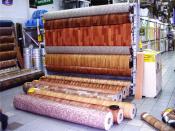Search
Login
Recommended
We stack the tongue-and-groove board, the technology of laying the tongue-and-groove board, useful tips
Attractive appearance, resistance to external destructive factors, light weight and uncomplicated installation process - these qualities today ensure the popularity of grooved boards, allowing it to withstand competition with other modern building materials. Not a grooved board is practically not used today - the combination of fragments end-to-end as a result of operation will quickly upset the surface deformation and the formation of cracks.
Content
- What is the difference between a grooved board
- How to choose a quality sheet pile
- Do-it-yourself sheet pile laying - general recommendations video
- How to lay a grooved board video video
- The house from the tongue-and-groove board - practical and convenient
What is the difference between a grooved board

The main difference between the grooved boards is the longitudinal protrusion available on the edge of the board. The tongue, this is the name of the protrusion, has dimensions and a configuration that allows it to fit snugly into the groove on the edge of the second board.

Depending on what material a tongue-and-groove board is made of, it can be used:
- For the subfloor - if the softwoods of conifers, such as pine, were used as the production material. Such boards have a sufficiently high moisture resistance, but after installation they must be opened with varnish.
- For the final floor - if high quality solid wood was used as the starting material - oak or ash. It has a higher cost, the indicator of its moisture resistance refers to the average. Among the shortcomings of such material, instability to the effects of fungi should be noted. The highest quality sheet pile of larch is considered. It is resistant to moisture and is not afraid of fungi and mold. Its cost is 2, or even 3 times higher than the cost of an analogue of coniferous wood. In addition, the larch board is very decorative, has a beautiful pattern and a pleasant shade. It can be laid with or without varnish, but it should be borne in mind that the boards opened with varnish will last much longer.
Since wood materials tend to deform when dried, it is recommended to choose a board dried in an autoclave, with a minimum moisture content (up to 10%). Before proceeding with the installation, it should be kept in the conditions of the room where it will be mounted.
Commercially available tongue-and-groove boards are from 1 m to 5 m long; when buying them, you should not forget that about 10% of the material may be scraped.
How to choose a quality sheet pile

The creation of a beautiful and durable flooring depends on the quality of the material used and on the efforts of the person performing his installation. Therefore, the choice of material is a very important task, which will need to be solved competently. Since the construction of the tongue-and-groove board implies installation with the exact entry of the tongue into the groove, it is necessary to verify the quality by experience - after a light click when connecting the boards should form a perfectly flat surface, without gaps.

With proper processing of wood in the production process, the board acquires high sound and heat insulation characteristics. If the installation technology was sustained, and floor care is carried out according to the rules, then it will serve for several decades.
Before buying a grooved board, you need to perform the correct calculation of its quantity. Take into account the dimensions of the room, as well as the length and width of commercially available standard boards. Usually they have the following parameters:
- length - from 3 m to 6 m,
- width - from 70 mm to 145 mm
- thickness - from 28 mm.
It is rather difficult to select the optimal size fragments, if possible, it is better to contact the company that produces them and order sawing according to the drawn plan of the covered surface.
You should make sure that the board has low humidity - for any type of drying, natural or industrial, the humidity range optimal for quality material is from 10 to 16%. Humidity control is carried out by inspection - its surface after drying becomes shiny, the dullness inherent in a raw tree should completely disappear. When tapped, it should make a loud sound. When touching with your hand, you should not feel a wet surface.

Grooved board is classified by quality - grade A to C and Extra. For a rough floor, a class C board is used, which may have knot openings and an acceptable number of black knots. Installation of grooved boards of Extra class involves the creation of a high-quality finished floor.
Do-it-yourself sheet pile laying - general recommendations

You can install a wooden floor on the logs or on a concrete surface. In any case, the base is leveled to perfect condition, cleaned of debris, dried. If the floors will be laid on logs, then the wood will need to be treated with antiseptics. Logs are laid at regular intervals of 0.5 m, at the joints they leave a gap of 2 cm - this will prevent the possibility of sticking out the bars to each other. If the laying of the floor from the grooved board will be carried out diagonally, then the distance should be reduced to 35 cm.
To ensure a long period of operation, it is necessary to ensure good ventilation of the flooring, do not fill the voids under it.
Fragments are fastened to the logs using self-tapping screws (3x40 or 3x35), holes are drilled for them every 0.4 m. The boards should be laid with their closest fit, if necessary, with the help of wedges.
Around the edge of the room’s perimeter leave a gap of the order of two or three cm; the baseboard will close it. On both sides of the room, solid boards should be laid near the wall, they are fixed with horizontally screwed screws. When installing the central part of the floor, you can use shorter sections of the board.
To ensure a more snug fit of the elements, they are tapped with a rubber or wooden hammer, placing a wooden block between the board and the hammer to prevent damage to the crest.

In a similar manner, the tongue-and-groove board is laid on a concrete base. With this method, it will be necessary to equip the waterproofing layer; as an insulator, moisture-resistant plywood 16 mm thick can be used. Sheets of plywood are laid diagonally, the distance between them should be 2-3 cm, gaps of 1.5 -2 cm are also left near the walls.
To give the floor perfect smoothness after laying, the grooved boards are sanded.
How to lay a grooved board
When constructing the floor in the room, it is customary to choose the orientation of the boards parallel to the light flux coming from the windows. When installing the floor in the corridor or vestibule - boards are placed along the movement vector. Laying is performed without or without displacement of the elements.
When mounting into a runaway, a very careful trimming of each element will be required, the flawless execution of a right angle can be a difficult task for a person who performs such a job with his own hands for the first time. Therefore, experts recommend getting a pattern and marking the sawing lines in strict accordance with it.
Around the perimeter should leave a margin of 1.5-2 cm from the walls (the so-called expansion joints) at the end of the work, they will be closed with a skirting board.
Laying the first board is done with a tongue to the wall, this will simplify the laying and fastening of the following fragments. When laying the second - be sure to combine the spike and groove. It is not recommended to use nails for attaching boards - their hats will begin to come out over time, the nails themselves can be destroyed by rust. As we mentioned above, it is better to use self-tapping screws.
Subsequent rows are laid in a similar way, while it should be borne in mind that for the fifth row you will need to use a full-sized board. Thus cover the entire area of \u200b\u200bthe room. Solid boards will be required for laying the last two rows. To fit the last board, if necessary, cut along with a circular saw.
Fasteners can be made in different ways:
- without a bias of self-tapping screws, then you will need to seal each cap with sealant,
- with a slope of 45, this option looks more aesthetically pleasing. Fasteners are also made around the perimeter, then the baseboard is mounted. Boards begin to be laid after complete installation of the lag, the joints of the boards should be in the middle of the lag.

Next, the floor is prepared for finishing work: if the boards are even, it will be enough to process them with sandpaper (180 grit), if there are significant defects, scraping will be required. It should be carried out carefully so that chips do not come off the boards.
The final stage of work is to clean the floor from debris and dust, it is best to use a vacuum cleaner. Then the boards should be treated with a primer - it will provide increased adhesion. When choosing paints and varnishes, preference should be given to polymer one-component compositions made on a water basis.

They dry quickly, they do not emit harmful substances and unpleasant odors. They are applied in two layers, the first should be thin, the second can be applied only after a couple of hours. Such a floor finish will increase its moisture resistance and attractiveness. Improving performance will significantly extend its service life.
The house from the tongue-and-groove board - practical and convenient
Modern summer cottage construction involves not only the installation of flooring from grooved boards, but also the construction of houses from it. The thickness of the board used to build the walls can be different. The low level of humidity of the board (about 15%) allows you to get a quick shrinkage of the structure.

Among the advantages of tongue-and-groove houses, you should remember:
- high environmental friendliness
- the opportunity to get considerable savings in decoration,
- attractive appearance
- sufficiently high heat and sound insulation qualities,
- the opportunity to get a structure of any size,
- the ability to use it as a material for walls, ceilings and floors,
- long service life.





